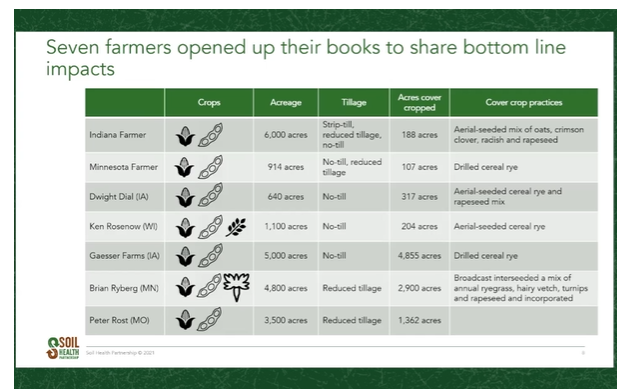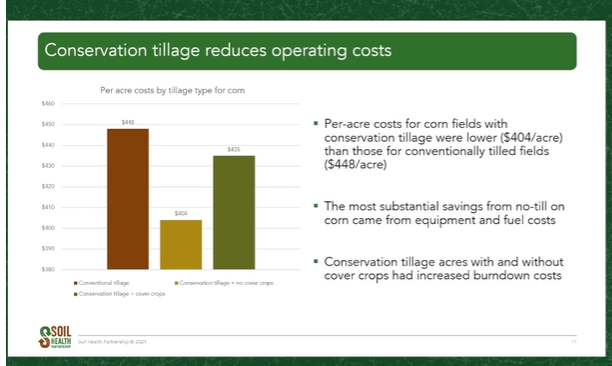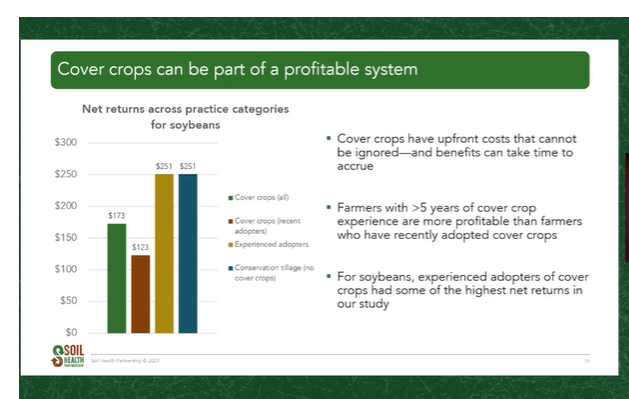New Study Details Financial Risks And Rewards With Conservation Farming Practices

Conservation practices are readily available for U.S. farmers to implement, but financial roadblocks commonly stymie their adoption. A study done in 2020 in

The team found three key takeaways, which were addressed by Maria Bowman, PhD, SHP lead scientist, and Vincent Gauthier, EDF research analyst, on Wednesday during the 2021 Commodity Classic.
1. Conservation tillage systems showed higher net returns versus conventional tillage and reduced farmer operating costs.
Fields using conservation tillage practices achieved higher net returns per acre than conventionally tilled fields for both corn and soybeans.
In corn, Gauthier says average net returns for conservation tillage were $377 per acre, while averages for conventionally tilled fields were $324 an acre.
Conservation-tilled corn fields had substantially lower costs ($404 per acre) than those with conventional tillage ($448 per acre).

In soybeans, Gauthier says the average net returns for fields with conservation tillage were $251 per acre, while average net returns for conventionally tilled fields were $216 per acre.
He adds that soybean fields with conservation tillage and no cover crops had substantially lower per-acre costs ($217 per acre) than conventionally tilled fields at $311 per acre. However, Gauthier points out that soybean fields using both conservation tillage and cover crops had similar costs to conventional tillage.
2. Cover crops can be part of a profitable production system, especially as farmers’ experience with them increases over time.
The research team says the initial investments in cover crops cannot be ignored.
“I think it's really important to acknowledge right up front that cover crops do have costs associated with them – seed, planting costs and burndown as well as learning costs,” Bowman says.
“Cover crops are an investment for farmers as they learn what types of cover crop species and mixes work on their farm, how to plant them, and how to terminate them. And sometimes the benefits take a while to show up, whether it's an improvement in soil structure, nutrient cycling or availability,” she adds.

The research also showed that experienced cover crop adopters had fewer costs than farmers who were new to using cover crops. On corn acres, experienced adopters saved $9.19 per acre on cover crop seed compared to recent adopters, $25 per acre on fertilizer and $25 per acre on equipment.
Likewise, experienced adopters had similar cost savings on soybean ground, including $5.90 per acre on cover crop seed, $48 per acre on fertilizer and $28 per acre on equipment.
3. Success with conservation practices is optimized with a targeted, stepwise approach.
Bowman says the researchers found that the farmers who participated in the study had clearly defined goals they wanted to achieve which contributed to their success.
Two goals were especially prevalent for the seven participants: 1. Most wanted to improve soil structure to help with erosion control and water-holding capacity. 2. Several of the farmers wanted to reduce the number of hours on the tractor to save time, machinery and overhead costs.
Overall, participating farmers weighed the risks and rewards of adopting specific conservation practices before implementing them.
“We saw farmers targeting specific combinations of practices to specific acres depending on the goals that they had,” Bowman says. “They weren't just going no-till across their whole operation or applying the same cover crop. Their decisions depended a lot on the rotation, or the land that they were working on, and sometimes it depended on whether they rented or owned that land.”
Gauthier says the business case for adopting conservation practices can be complex and that financial solutions still need to be developed to help farmers implement such practices.
“There are still financial gaps that need to be overcome,” he says. “One way farmers can minimize their risk is by using a collective network approach, like through the Soil Health Partnership, which allows for collective learning. That can help farmers reduce the risk and uncertainty about taking on a new practice that is unproven on their operation.”
More information on the study, the farmers involved in it and the detailed research results are available at www.soilhealthpartnership.org/farmfinance







